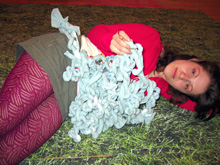Fibres media encourage artists to express emotion

Susan Wolf spills her Guts in latest show by Fibres students.
Photo by Robert Winters
The end of her relationship hit student Susan Wolf very hard, but instead of moping around after the painful breakup, she used her Fibres course to work through her feelings and deal with it in a positive way.
The result was a unique piece of artwork called Guts, which represents the gut-wrenching experience that Susan went through before she was able to “build a bridge to the next phase of my life.”
Susan took bed sheets used by the couple and wrote on them letters exchanged during the breakdown of the relationship. She then tore the sheets into strips and twisted them to resemble parts of the digestive system.
“I was spilling my guts on the table,” Susan said as she fingered the twisted fabric of her piece.
The project was enhanced by Susan’s interest in anatomy and her background in medical anthropology, including a job as a research assistant at the Montreal Children’s Hospital, where she worked with families with children in the intensive care ward.
When she broke up with her boyfriend, she quit her job “and decided to become an artist” by coming to study at Concordia.
Susan’s piece was presented as part of Stuff, the Fibres Student Association’s end-of-year show at the Belgo Building in downtown Montreal, which featured the work of 20 Fibres students in a juried exhibition.
The show presented work that covered a wide variety of materials and styles. Many of the pieces had strong conceptual content, in which the artist seeks to express compelling ideas and emotions in ways meant to cause a reaction in the viewer.
The work for the show was chosen by Associate Professor Ingrid Bachmann, graduate student Andrea Vander Kooj, and Melissa Matos, the exhibition’s organizer, who has led the student association this year.
Melissa said the variety of work chosen showed the diversity of work being done in the Fibres program, mainly because of the strong interdisciplinary approach students are encouraged to incorporate from their other courses outside the Fibres area. “This diversity is what makes Fibres such an intimate yet exciting area,” Matos said.
This interdisciplinary approach in Fibres is ideal for another artist in the show, Ed Janzen, who presented a large tablecloth featuring a U.S. aircraft carrier and its accompanying ships and planes.
“The size of the piece is intended to convey the scale of American military power,” Janzen said. His work is meant to also remind viewers of the billions of poor people in the world who “are prevented from taking their seats” at the world’s table.
Janzen is an Interdisciplinary Studies student in his first year at Concordia after studying medieval history at the University of Manitoba. He said he is drawn to fibres because the materials often are associated with “domesticity, celebration and softness.” He can contrast them with his favourite themes of examining global structures in the military, political and economic spheres.
This contrast between the softness of textiles and the hard-edged themes being used increasingly by artists in this program could also be seen in work by Carla Benzan, co-director of the student-run VAV Gallery this year. Carla, a Painting and Drawing student, presented several large sculptures resembling internal organs that were suspended eerily at the entrance of the gallery.